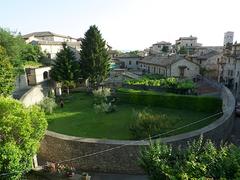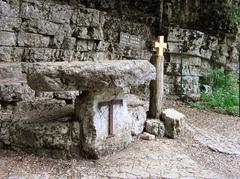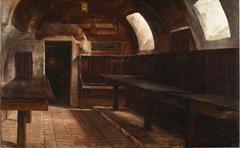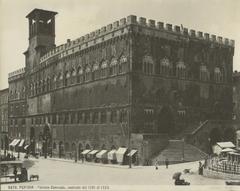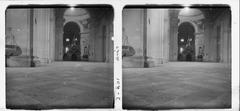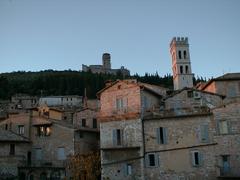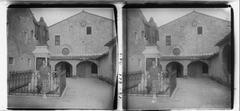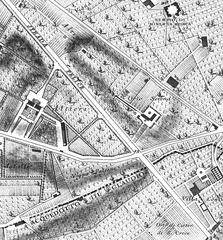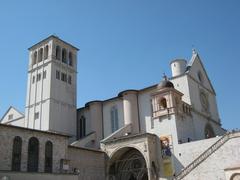Torre di Torchiagina: Visiting Hours, Tickets, and Historical Guide in Assisi, Italy
Date: 14/06/2025
Introduction
Torre di Torchiagina is a remarkable medieval tower set in the tranquil Umbrian countryside just northwest of Assisi, Italy. Dating from the 13th or 14th century, it originally served as a strategic military outpost and feudal stronghold, overseeing vital trade routes and fertile agricultural lands that connected Assisi with neighboring towns like Perugia (Life in Italy; Mondimedievali). Today, the tower stands as a symbol of the region’s resilience and cultural continuity, drawing visitors interested in history, architecture, and the serene beauty of Umbria.
This guide provides comprehensive details on the history, architecture, significance, visiting hours, ticketing, accessibility, travel tips, and nearby attractions, ensuring an enriching experience for every visitor.
Early Origins and Medieval Context
Torre di Torchiagina’s roots trace back to the Middle Ages, when central Umbria was a mosaic of fortified towers and castles. The region’s strategic importance meant that such structures were built both for defense and as symbols of feudal power. The tower likely dates to the 13th or 14th century, a period marked by ongoing conflicts and shifting political alliances. Towers like Torchiagina offered protection, enabled the control of trade and agricultural production, and provided a focal point for rural communities (Life in Italy).
Strategic Significance in the Umbrian Landscape
Torre di Torchiagina’s location allowed surveillance over the Chiascio River valley and the monitoring of routes connecting Assisi, Perugia, and other towns. This was crucial during the Guelph-Ghibelline conflicts and subsequent struggles between local powers. The tower also served as an administrative center for collecting agricultural produce and taxes, often under the authority of powerful monastic institutions (Jam Travel Tips).
Architectural Features and Preservation
The tower is a textbook example of medieval Umbrian military architecture: built of local limestone and brick, with thick defensive walls and narrow slit windows. Its square or rectangular plan offered both strength and a commanding view of the countryside. Over the centuries, the tower has been restored and modified, but its essential medieval character remains intact (allwebitaly.it).
Role in Local History and Community Life
The hamlet of Torchiagina developed around the tower, which provided security and a sense of identity to local residents. Beyond its defensive role, the tower became a hub for agricultural management, religious observance, and social gatherings. Festivals and traditions often centered on the tower, cementing its role as a symbol of continuity and community resilience.
Connections to Assisi’s Broader Historical Narrative
Torre di Torchiagina’s history is inextricably tied to Assisi’s own development. The wealth generated by pilgrimage, agriculture, and trade supported the construction and maintenance of such towers, and the fortunes of Torchiagina often mirrored those of Assisi, especially during periods of political, religious, and social change (Jam Travel Tips).
Restoration and Modern-Day Significance
Restoration efforts in recent years have stabilized the tower, repaired masonry, and improved accessibility. These projects are part of a broader commitment to sustainable tourism and cultural preservation in Umbria. The tower now attracts history buffs, architecture enthusiasts, and travelers seeking authentic experiences away from the crowds (Torrenova Storia; Vagrants of the World).
Visitor Information: Visiting Hours, Tickets, and Accessibility
- Visiting Hours: The tower is generally open from April to October, Tuesday through Sunday, 9:00 AM to 6:00 PM. Closed Mondays and major holidays; hours may change during restoration.
- Tickets: Admission is €5 for adults, €3 for EU citizens aged 18–25, and free for children under 18. Tickets are available on-site or via the official Assisi tourism website.
- Accessibility: Limited wheelchair access due to the historic design; the exterior and village surroundings are accessible via paved paths.
- Guided Tours: Available on request via local tourism offices or cultural associations. Tours include insights into the tower’s history and the Umbrian landscape.
For current information, check the official Assisi tourism site or contact the Torchiagina visitor center.
Visitor Experience and Practical Travel Tips
- Best Time to Visit: Spring and early autumn offer mild weather and fewer crowds.
- Getting There: The hamlet is accessible by car or bicycle from Assisi; public transport is limited.
- Nearby Amenities: Cafés and inns in Torchiagina provide traditional Umbrian hospitality.
Integration with Regional Attractions
Combine your visit with Assisi’s famous sites such as the Basilica di San Francesco, Rocca Maggiore fortress, and Sanctuary of Rivotorto. The countryside is ideal for exploring medieval towns and enjoying Umbrian food and crafts (Life in Italy).
FAQ: Common Questions About Visiting Torre di Torchiagina
-
Is Torre di Torchiagina open year-round?
No, it is usually open April–October. Check current schedules before visiting. -
How can I purchase tickets?
On-site or through the Assisi tourism website. -
Are guided tours available?
Yes, via local tourism offices or cultural groups. -
Is the tower wheelchair accessible?
Accessibility is limited inside; the surrounding area is more accessible. -
Can I visit with children?
Yes, but supervision is recommended due to the historic structure.
Architectural Features and Setting
Medieval Origins and Structural Evolution
The tower’s medieval origins are evident in its robust masonry and strategic placement. It has been rebuilt and adapted multiple times, blending original elements with later additions (allwebitaly.it).
Exterior and Interior Characteristics
- Exterior: Constructed from local limestone and sandstone, the tower features slit windows and a traditional tiled roof.
- Interior: Original stonework is preserved. The ground floor was once a refuge; upper rooms now offer panoramic views.
- Unique Features: The tower is part of a complex including gardens, a panoramic terrace, and the 16th-century Cappella di San Girolamo (allwebitaly.it).
Artistic Elements
The adjacent parish church features modern Romanesque frescoes by Francesca Capitini (assisioggi.it). The tower complex occasionally hosts art exhibitions and local workshops.
Setting and Surroundings
Set in rolling hills overlooking the Chiascio River, the tower is surrounded by olive groves, vineyards, and woodlands. The site is accessible from Assisi, with good road connections and nearby parking (mapcarta.com).
Visitor Information Summary
- Hours: Tuesday–Sunday, 10:00 AM–6:00 PM (April–October)
- Tickets: €8 adults, €5 students/seniors, free under 12. Guided tours on request.
- Getting There: Car recommended; local buses from Assisi available.
- Accessibility: Pathways and lower floors accessible; upper floors may be limited.
- Nearby Attractions: Basilica di San Francesco, Rocca Maggiore, parish church with frescoes.
- Events: Medieval fairs, art exhibitions, workshops—check official schedules.
Frequently Asked Questions (FAQ)
-
Are tickets available online?
Yes, via the official website. -
Is the site family-friendly?
Yes, with family rooms and workshops for children. -
Can I bring pets?
Pets are allowed in outdoor areas. -
Is photography allowed?
Personal photography is permitted; professional shoots require permission. -
Is there Wi-Fi?
Yes, in common areas.
Historical and Strategic Role
In the 14th century, Torre di Torchiagina defended Assisi from rival Perugia and controlled key transit routes. It later became a feudal property, with noble families such as the Bindangoli and Fiumi di Roncalli leaving their mark (Mondimedievali; Torrenova Storia).
Cultural Heritage and Community Identity
The tower remains a focal point for the local community of Torchiagina, hosting events like the Sagra dell’Oca Arrosto and serving as a museum and osteria managed by local volunteers (Torrenova Storia; Wikipedia).
Nearby Attractions and Travel Tips
- Assisi: Basilica di San Francesco, Rocca Maggiore, Santa Maria degli Angeli (GoAskALocal).
- Other Fortified Villages: Sterpeto, Rocca Sant’Angelo, Beviglie, San Gregorio (Torrenova Territorio).
- Stay: Torrenova di Assisi Country House for a local experience.
Practical Tips
- Best visited in spring or autumn.
- Wear comfortable shoes and bring a camera.
- Car rental recommended.
- Respect local customs and check festival calendars.
Conclusion
Torre di Torchiagina offers a unique window into the medieval history and rural culture of Umbria. While interior access may be limited, its imposing presence and the surrounding landscape provide a rewarding stop for travelers. Combine your visit with Assisi’s UNESCO sites, local festivals, and countryside exploration for a truly immersive experience.
Plan Your Visit
Download the Audiala app for personalized travel guides, ticket bookings, and event information. Follow local social media channels for news and special offers. For additional resources, explore:
